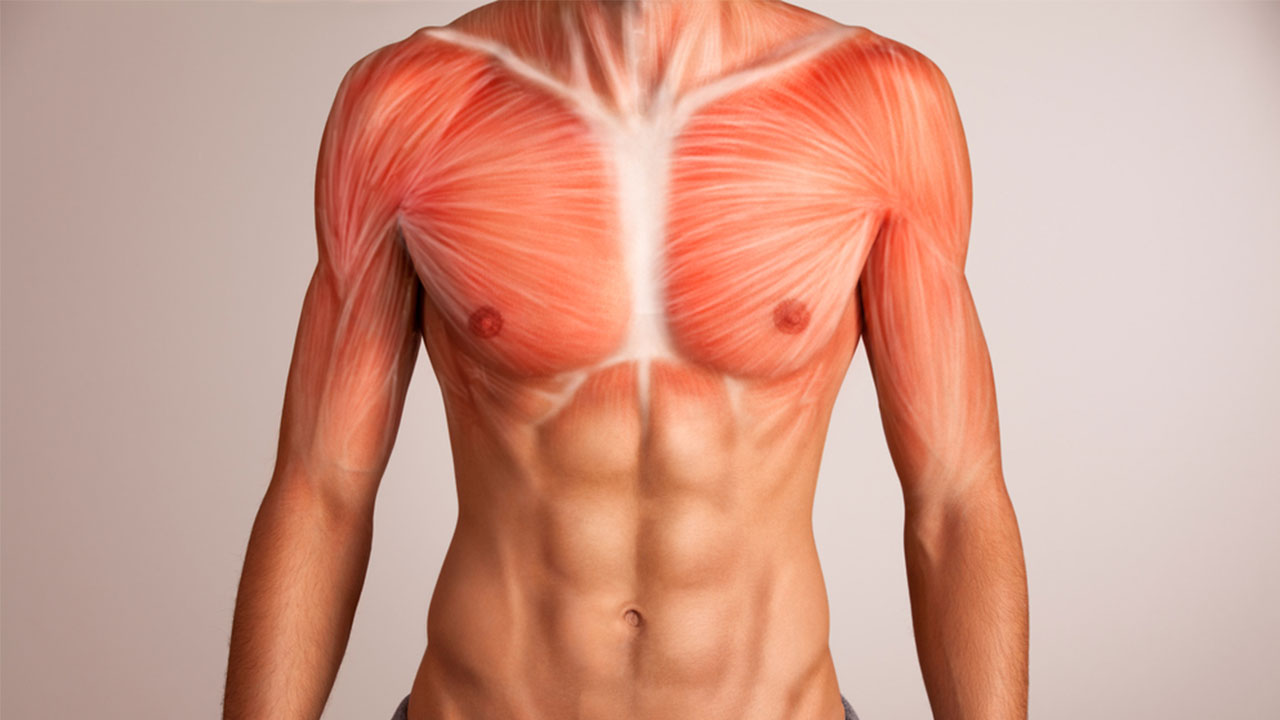Torn Pectoral Muscle Recovery Time: How to Speed Healing and Prevent Reinjury
 By: by Amino Science
By: by Amino Science

When you think of muscle tears, your mind probably conjures up arm or leg injuries. But the truth is you can tear almost any muscle, including your chest muscles. While most of us probably won't find ourselves in the type of situation that can lead to a chest muscle injury, some groups—most notably weight lifters—are actually prone to these types of muscle tears, especially tears of the pectoralis muscle. But what causes a pectoral muscle tear, how can you avoid it, and, if you're currently suffering from one, what can you expect in the way of torn pectoral muscle recovery time?
In this article, we're going to uncover the answers to each of these questions to help you avoid injury or speed healing of a current tear.
What Is the Pectoral Muscle?
The pectoral muscles are made up of four muscles that connect the chest wall with the upper arm bone, or humerus, and shoulder:
- Pectoralis minor
- Pectoralis major
- Serratus anterior
- Subclavius
The largest of these muscles, the pectoralis major muscle, attaches at the breastbone, or sternum; the clavicular head of the collar bone, or clavicle; and the humerus. This large muscle, which most of us typically think of as one of the pecs, plays a significant role in shoulder movement and is easily recognized by its wide fan shape.
The much smaller pectoralis minor lies under the pectoralis major and attaches to the ribs and the front of the shoulder at the scapula. This muscle aids both scapular movement and breathing.
Like the pectoralis minor, the serratus anterior attaches to both the ribs and scapula. This muscle helps support breathing and elevation of the arm and allows the arm to rotate and pull the scapula around the rib cage.
The smallest of the pectoral muscles is the subclavius, which attaches to the clavicle and first rib. This muscle is responsible for stabilizing the collarbone during arm movement and for lowering the clavicle and elevating the first rib during respiration.
Of these four muscles, the one most likely to become injured is the pectoralis major muscle.
Types of Pectoralis Major Muscle Tears
Under the right circumstances—more on that in a moment—both the pectoralis major muscle and the pectoralis major tendon are susceptible to injury. Depending on the severity of a pectoralis major rupture, a partial or complete tear may result. However, tears of the pectoralis major muscle are classified as one of four types:
- Type 1: With type 1 tears, the pectoralis major tendon pulls away from the humerus.
- Type 2: With type 2 tears, the rupture occurs at the muscle-tendon junction—the point where the muscle begins to transition to tendon.
- Type 3: With type 3 tears, the pectoralis major muscle rupture occurs entirely within the muscle belly.
- Type 4: On the opposite end of the spectrum is the type 4 tear, in which the muscle pulls away from the sternum.
While partial tears of the pectoral muscles do occur, complete ruptures, in which either the muscle or tendon tears away from bone, are more common.
Now, how do you go about injuring your chest muscles?
Torn Pectoral Muscles: Causes and Symptoms
It turns out that what used to be a rather rare injury is becoming increasingly more common. In fact, studies have found that over three quarters of reported cases of torn pectoral muscles have occurred during the past 20 years alone.
And the cause of these injuries?
While pectoral muscle injuries can be the result of trauma, they're most commonly seen as a consequence of overuse and are especially associated with weight training.
And not just any weight training, but the bench press—one of the most popular exercises among weight lifters.
Because the bench press requires a huge amount of force from the pectoralis major muscles, any tension or weakness in the muscles, or even steroid use, can impact their ability to perform the exercise.
However, the muscles don't tend to rupture without warning. On the contrary, they usually feel tight or begin to spasm. But because many weight lifters are trained to push through the pain, they go beyond their limits, taxing the pectoralis beyond its breaking point.
And the result is sudden pain and a tearing sensation that many describe as feeling like the muscle has unzipped itself. In addition, depending on the severity of the tear, there may also be loss of strength, swelling, dark bruising throughout the affected chest and armpit area, and a bunching up under the skin where the muscle has retracted.
Pectoral Muscle Tear Treatment
If you've experienced a pectoralis major tear, treatment will depend on whether you have a complete or partial tear.
If the pectoralis tendon or muscle has completely torn away from its attachment—and you're an athlete or individual who wishes to return to vigorous activity—your best bet for achieving your previous level of functioning is opting for surgical repair.
If you suffer a partial tear of the muscle belly, you'll likely be able to care for the injury yourself. However, following an appropriate treatment protocol is the surest way to ensure the muscle heals properly.
So after you've had the injury examined to make sure surgical treatment isn't necessary, it's important to apply ice to the area for 10 to 15 minutes every few hours for 36 to 48 hours to reduce swelling and bruising. Then, when the acute pain has passed, it's time to start working the muscle.
Exercise
When you've experienced a pectoral muscle tear, the best way to minimize scar tissue formation and maximize function is by focusing on a progressive program of stretching and strengthening.
While rest is extremely important during the acute phase of any muscle injury, resting for too long can actually be counterproductive. This is because an injured muscle begins to lay down scar tissue as it attempts to repair itself. Although scar tissue is better than nothing, it's stiff and inflexible when compared with muscle tissue.
However, if we begin stretching and strengthening as soon as possible, we encourage the muscle to instead lay down new muscle fibers.
So when you begin working with your muscle injury, use the following as a guideline:
- Warm up. Before you begin any stretching or strengthening exercises, first apply a hot pack to the injured area for 10 to 15 minutes. This will get blood flowing through the area, which will make the muscle more elastic and responsive to your rehab protocol.
- Begin range of motion. Begin slowly moving your injured arm through a wider and wider range of motion. If pain level permits, continue this movement until you achieve a full range of motion.
- Begin stretching exercises. Actively stretch the injured arm by holding on to a doorway hinge and rotating the hips away or by twisting at the waist and extending the injured arm out behind you. Do this for 10 to 15 seconds 2 to 3 times.
- Begin strengthening exercises. As soon as pain level permits, choose an exercise that directly works the injured area. Beginning with just your own body weight, perform 2 to 3 sets for 15 to 20 repetitions. Progress the next day—or as quickly as your pain level permits—to using light weights for the same amount of sets and repetitions. (While resistance bands are perfect for rehabbing a muscle injury, weight lifters who originally injured themselves bench pressing may choose to treat their injury using the same exercise—and similar guidelines.) Gradually increase weights as tolerated over the next few days, using your pain level and ability to perform the exercise with proper form as a guide.
But, remember, there's a trick to ensuring you're rehabbing the muscle and not reinjuring it.
What is it?
Listening to your body.
After all, unless you were involved in a traumatic accident, chances are you tore your pectoral muscle by not listening to your body. In other words, you ignored the tightness or spasm or whatever and pushed through the pain.
Don't do that.
Instead, regardless of whether you're stretching or strengthening, pay attention to your pain. If it rises above the level of discomfort, stop what you're doing and rest or take it down a notch.
Diet
Believe it or not, the extent of scar tissue you develop after a muscle injury is partly related to the type of diet you eat. This is because chronic inflammation contributes to both scar tissue formation and how well your body is able to perform muscle protein synthesis.
Diets high in sugar, refined carbohydrates, and saturated fat are known to trigger inflammation, but diets that emphasize fruits, vegetables, lean proteins, and omega-3 fatty acids can actually reduce harmful levels of inflammation.
Vitamin D has also been found to decrease inflammation and increase muscle protein synthesis. What's more, it's been shown to increase the number and quantity of fast-twitch muscle fibers—special cells involved in the production of powerful movements.
Amino Acids
All the protein in the body is made up of amino acids—the building blocks of life. Yet, there are nine amino acids, the essential amino acids, we must obtain from our diet.
While amino acids can be obtained by simply eating more protein, muscle growth can be further enhanced by supplementing with a high-quality essential amino acid supplement.

Torn Pectoral Muscle Recovery Time
With proper treatment, a pectoralis muscle tear should heal very well. However, depending on the severity of the injury, method of treatment used, and diligence with therapy, full recovery can take several months to a year.
In the case of complete muscle or tendon ruptures requiring surgery, it may take 6 to 8 months before you're able to participate in normal activities. And it may take another year before your strength has fully returned.
For tears of the muscle belly, daily stretching and strengthening following the protocol mentioned above can have you back up and running within as little as 2 months.
And, of course, supplementing your therapy with a healthy diet and amino acids can go a long way toward reducing your recovery time. Heal is a specially formulated blend of essential amino acids that is proven to help speed up recovery time and help you mend stronger. Find out more here.
How to Avoid a Pectoral Muscle Tear
While some traumas are unavoidable, there are certain things you can do to reduce your chance of having a pectoralis muscle injury.
- Watch your form. If you're bench pressing, avoid flaring your elbows. This technique, which some weight lifters recommended for increasing pec load and thus muscle growth, is actually a recipe for a pec tear. Instead, lower the bar to the base of the breastbone, keep the elbows in and forearms at right angles to the bar, and imagine you're pulling the bar apart.
- Don't take steroids. Even with their known dangers, some weight lifters continue to use steroids. However, aside from their potential deleterious effects on the heart, liver, bones, and more, steroids can cause your muscles to outgrow their attachments, which greatly increases the risk of a rupture.
- Eat well. Don't wait until an injury occurs to eat a healthy diet. By focusing on healthy foods all year round, you'll be supplying your body with the nutrition it needs to keep itself naturally strong.
- Take amino acids. Like a good diet, amino acids aren't just for treating injuries. They can also encourage healthy muscle growth and improved strength.
If you've experienced a pectoral muscle injury but aren't seeing results with conservative treatment, don't hesitate to speak with a qualified health care professional about further testing.

Up to 25% off Amino
Shop NowComments (0)
Most Craveable Recipes




 833-264-6620
833-264-6620



















